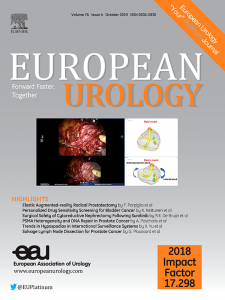Vesical Mucosal Graft for the Treatment of Ureteral Strictures with a Total Robot-assisted Approach
IF 25.2
1区 医学
Q1 UROLOGY & NEPHROLOGY
引用次数: 0
Abstract
Background and objective
Ureteral strictures can be iatrogenic and caused by stones, radiation, autoimmune diseases, and trauma. Laparoscopic or robot-assisted ureteroplasty (RAUP) with grafts for short ureteral strictures has been described in several studies. Our objective was to show the efficacy and safety of vesical mucosa grafts (VMGs) for treatment of ureteral strictures via RAUP.Methods
We conducted a single-center retrospective study to evaluate the role of VMGs in the treatment of iatrogenic ureteral strictures in a cohort of 14 patients who underwent RAUP. Descriptive analyses of clinical and demographic data, including stricture length, operative time, hospitalization, complications, and follow-up, were performed. All patients underwent RAUP using VMGs with a da Vinci Xi robotic system.Key findings and limitations
Mean stricture length in the cohort was 4.07 cm (range 3–6). The mean operative time was 141 min (range 110–180) and the mean hospital stay was 6.3 d (range 5–10). No Clavien-Dindo grade >2 complications were observed. No stenosis recurrence had occurred at 21.3 mo. Limitations include the small sample size and short follow-up.Conclusions and clinical implications
Our study shows that RAUP with VMGs may represent a valid approach for the treatment of ureteral strictures of up to 6 cm in length.膀胱粘膜移植在全机器人辅助输尿管狭窄治疗中的应用
背景与目的输尿管狭窄可能是医源性的,由结石、放射、自身免疫性疾病和创伤引起。一些研究描述了腹腔镜或机器人辅助输尿管成形术(RAUP)与移植物治疗短输尿管狭窄。我们的目的是显示膀胱粘膜移植(VMGs)治疗经RAUP输尿管狭窄的有效性和安全性。方法采用单中心回顾性研究,对14例接受RAUP治疗的患者,评价VMGs在治疗医源性输尿管狭窄中的作用。对临床和人口学资料进行描述性分析,包括狭窄长度、手术时间、住院、并发症和随访。所有患者均使用带有达芬奇Xi机器人系统的vmg进行RAUP。主要发现和局限性队列中的平均狭窄长度为4.07 cm(范围3-6)。平均手术时间141 min(110 ~ 180),平均住院时间6.3 d(5 ~ 10)。无Clavien-Dindo 2级并发症。21.3个月时没有狭窄复发。局限性在于样本量小,随访时间短。结论和临床意义我们的研究表明,RAUP联合VMGs可能是治疗长度达6cm输尿管狭窄的有效方法。
本文章由计算机程序翻译,如有差异,请以英文原文为准。
求助全文
约1分钟内获得全文
求助全文
来源期刊

European urology
医学-泌尿学与肾脏学
CiteScore
43.00
自引率
2.60%
发文量
1753
审稿时长
23 days
期刊介绍:
European Urology is a peer-reviewed journal that publishes original articles and reviews on a broad spectrum of urological issues. Covering topics such as oncology, impotence, infertility, pediatrics, lithiasis and endourology, the journal also highlights recent advances in techniques, instrumentation, surgery, and pediatric urology. This comprehensive approach provides readers with an in-depth guide to international developments in urology.
 求助内容:
求助内容: 应助结果提醒方式:
应助结果提醒方式:


